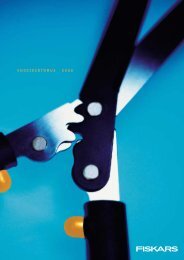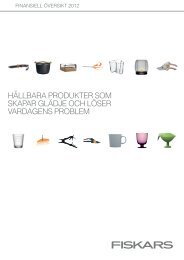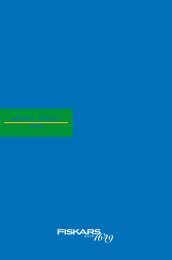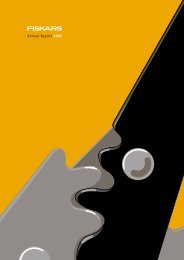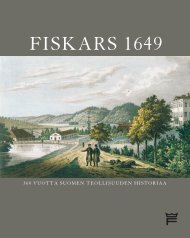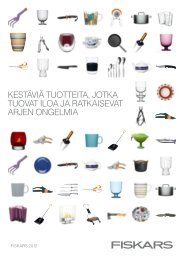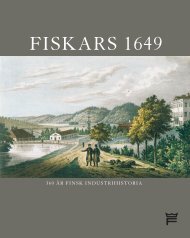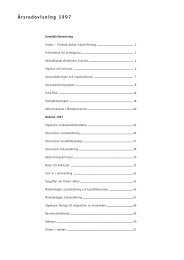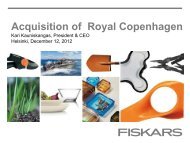FISKARS 1649 â 360 years of Finnish industrial history
FISKARS 1649 â 360 years of Finnish industrial history
FISKARS 1649 â 360 years of Finnish industrial history
You also want an ePaper? Increase the reach of your titles
YUMPU automatically turns print PDFs into web optimized ePapers that Google loves.
Fiskars <strong>1649</strong><br />
Fiskars <strong>1649</strong><br />
The 18th century<br />
Wars and shortages with contrasting technological progress<br />
By the 18th century Sweden-Finland was<br />
impoverished and disunited. One third <strong>of</strong><br />
Finland’s half a million inhabitants had<br />
died during the famine <strong>years</strong> <strong>of</strong> 1696–1697. The<br />
Great Northern War, during which the Russians<br />
systematically ravaged the <strong>Finnish</strong> coast, broke out<br />
in 1700. In 1712 – during the Great Northern War<br />
and on the eve <strong>of</strong> the Great Wrath – the number<br />
<strong>of</strong> workers at Fiskars and Antskog totalled only 25.<br />
Bollsta in Pohja was one <strong>of</strong> the centres <strong>of</strong> Russian<br />
civil and military administration during the Great<br />
Wrath, and Russians were active in the area. Many<br />
Fiskars workers lost their lives during the hostilities.<br />
When peace was made at Uusikaupunki in 1721,<br />
Sweden-Finland’s status as a great power collapsed.<br />
St Petersburg, founded in 1703 by Peter the Great,<br />
became a rapidly growing international centre and<br />
the capital city <strong>of</strong> Russia, the new great power on<br />
the Baltic Sea.<br />
After the Great Northern War, the Finns<br />
had no money to revive the ironworks. Wealthy<br />
Swedes from Stockholm invested money in<br />
<strong>Finnish</strong> ironworks, and a merchant named John<br />
Montgomerie bought Fiskars in 1731, recruiting<br />
more workers from abroad. In 1734, the Fiskars<br />
and Antskog ironworks employed nine smiths, two<br />
The silver cup given by the Royal Mines Authority to Anders Holmberg, who found the<br />
Orijärvi copper mine in 1758.<br />
Due to its high charcoal content, crude iron was brittle. Alternate heating and forging were used<br />
to remove all surplus charcoal and turn the iron into steel.<br />
20<br />
21



